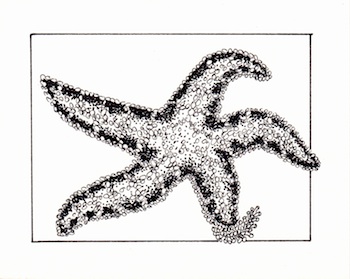By Mia Davidson and Jan Sattler
 Due to its bright coloring and star shape, the ochre sea star (Pisaster ochraceus) is one of the most beloved animals regularly seen along the Laguna coast. They live in ocean water of up to 300 feet deep but because they are tolerant of air exposure, they are frequently found at low tide attached to the rocks near the mussel beds. Ranging in color from brown to orange and red to purple, the surface of the animal is covered with light colored dots that are actually short blunt spines called ossicles. Adult ochre sea stars can reach up to 14 inches in diameter and can live for 20 or more years.
Due to its bright coloring and star shape, the ochre sea star (Pisaster ochraceus) is one of the most beloved animals regularly seen along the Laguna coast. They live in ocean water of up to 300 feet deep but because they are tolerant of air exposure, they are frequently found at low tide attached to the rocks near the mussel beds. Ranging in color from brown to orange and red to purple, the surface of the animal is covered with light colored dots that are actually short blunt spines called ossicles. Adult ochre sea stars can reach up to 14 inches in diameter and can live for 20 or more years.
Often found in crevasses near its favorite food, the mussel, they will also eat barnacles, limpets, snails and chitons. The underside of the ochre star is covered with hundreds of tiny suction feet. When feeding on mussels, the carnivorous sea star uses its suction feet to pry open the shell. It feeds by extending its stomach from the underside of its body and inserting it into the small opening in the mussel. It then uses digestive enzymes to soften and externally digest its prey, in a process that can take several days.
Ochre sea stars are broadcast spawners with chance fertilization occurring in open water. Main predators include sea gulls which attack their soft underside and human damage and collection. When a sea star is pulled from the tidepools, it rips off hundreds of their tiny suction feet compromising their ability to cling, which frequently causes them to die. In addition, as seen in Laguna Beach last August, the ochre sea star is also vulnerable to a wasting disease associated with warm water temperatures. Opportunities to see ochre sea stars are abundant in Laguna. In the local tidepools, Laguna Ocean Foundation educators and docents are happy to point them out to all visitors.
Mia Davidson and Jan Sattler are residents of Laguna Beach, year-round ocean swimmers and Board members of Laguna Ocean Foundation. No person shall take, possess or disturb specimens of live or dead intertidal marine animal or plant life, or willfully injure, destroy or alter marine intertidal zone habitats. (Ord. 1470 § 1 (part), 2007). For more information, go to www.lagunaoceanfoundation.org




